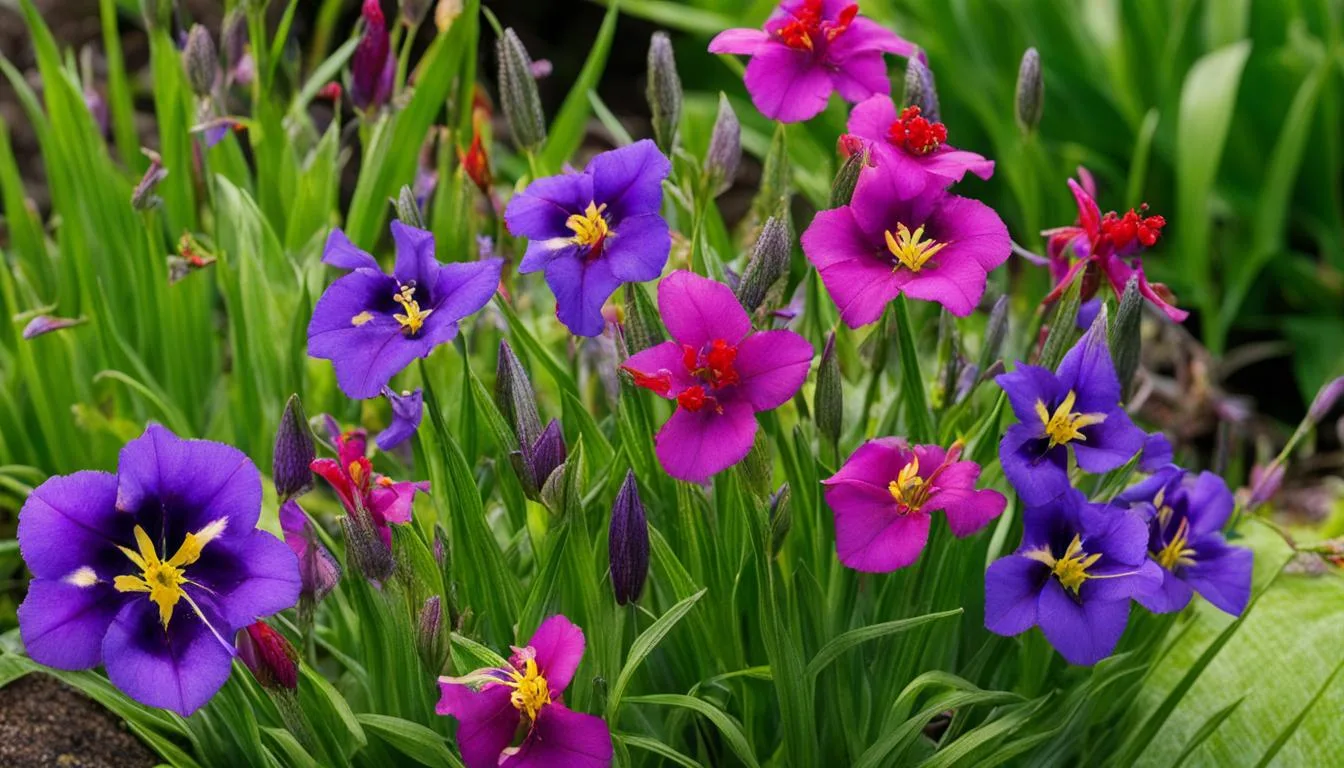
Growing spiderwort plants can be a delightful addition to any garden. With their beautiful flowers and easy maintenance, these plants are a favorite among many gardening enthusiasts.
In this article, I will guide you through the process of spiderwort cultivation and provide essential tips on how to care for your spiderwort plants.
Spiderwort plants belong to the Tradescantia genus and come in various species, including T. ohiensis, T. virginiana, and T. subaspera. They have long, strappy leaves and vibrant three-petaled flowers that bloom in the morning and close by early afternoon. Not only are spiderwort plants visually appealing, but they also attract pollinators to your garden.
When it comes to cultivating spiderwort plants, it is important to plant them in the spring. These plants prefer moist, well-drained soil and can tolerate a variety of soil conditions and pH levels. While spiderwort plants thrive in partial shade, they can also be grown in sunny areas.
Key Takeaways:
- Spiderwort plants have strappy leaves and colorful three-petaled flowers.
- They should be planted in spring and prefer moist, well-drained soil.
- Spiderwort plants can thrive in both partial shade and sunny areas.
- They attract pollinators to your garden.
- Spiderwort plants are easy to care for and require regular watering.
Spiderwort Varieties
Spiderwort plants come in a variety of stunning varieties, each with its own unique characteristics. These varieties not only differ in flower colors but also in foliage and growth habits. Here are some popular spiderwort varieties:
Tradescantia ‘Amethyst Kiss’
| Characteristics | Care |
|---|---|
| The ‘Amethyst Kiss’ variety features vibrant amethyst-purple flowers that bloom prolifically throughout the summer. Its grass-like foliage adds a touch of elegance to any garden. | This variety prefers partial shade and well-drained soil. Regular watering and occasional fertilization will help maintain its lush growth. |
Tradescantia ‘Concord Grape’
| Characteristics | Care |
|---|---|
| ‘Concord Grape’ variety showcases deep purple flowers that create a striking contrast against its green foliage. Its compact growth makes it suitable for smaller gardens or containers. | This variety thrives in full sun to partial shade and requires regular watering. Pruning after flowering will help promote bushier growth. |
Tradescantia ‘Sweet Kate’
| Characteristics | Care |
|---|---|
| ‘Sweet Kate’ variety is known for its vibrant golden-yellow foliage, which offers a stunning contrast to its deep blue flowers. It adds a pop of color to any garden or landscape. | This variety prefers full sun to partial shade and well-drained soil. Regular watering and occasional fertilization will help maintain its vibrant foliage. |
These are just a few examples of the spiderwort varieties available in the market. Each variety offers its own unique beauty and can be a wonderful addition to any garden or landscape.
Growing Spiderwort
If you’re interested in adding spiderwort to your garden, it’s important to know how to grow and propagate this resilient plant. Follow these simple tips to ensure successful spiderwort cultivation:
Spiderwort Growing Tips:
- Choose the right location: Spiderwort plants prefer partial shade but can also tolerate full sun. Select a spot in your garden that receives at least 4-6 hours of sunlight per day.
- Prepare the soil: Spiderwort plants are not too picky about soil conditions. They can grow well in various soil types, including loam, sandy, or clay soil. Ensure that the soil is well-drained and moist.
- Planting: Spring is the best time to plant spiderwort. Dig a hole that is slightly larger than the root ball of the plant, place the plant in the hole, and backfill with soil. Leave enough space between each plant to allow them to spread and grow.
- Watering: Spiderwort plants require regular watering, especially during hot summer months. Water them every few days, keeping the soil evenly moist. Avoid overwatering as it can lead to root rot.
- Propagation: Spiderwort can be propagated through division or stem cuttings. Divide the plants every few years to control their growth and rejuvenate them. To propagate through stem cuttings, simply cut a healthy stem, remove the lower leaves, and place it in moist soil or water until roots develop.
By following these growing tips, you can enjoy the beauty of spiderwort in your garden and attract pollinators with its vibrant flowers.
| Spiderwort Growing Tips | |
|---|---|
| Choose the right location | Partial shade or full sun |
| Prepare the soil | Well-drained and moist soil |
| Planting | Spring season |
| Watering | Regular watering, every few days |
| Propagation | Division or stem cuttings |
Spiderwort Care and Maintenance
When it comes to caring for spiderworts, they are relatively low-maintenance plants that can thrive in various conditions. Here are some tips to ensure the health and beauty of your spiderwort plants:
- Watering: Spiderworts prefer consistently moist soil, so regular watering is essential. During hot summer months, it’s important to water every few days to prevent the soil from drying out.
- Pruning: To maintain a neat appearance and promote bushier growth, regular pruning or pinching back of the stems is recommended. Shearing the plants after flowering can also help prevent re-seeding and control their invasive nature.
- Fertilization: Spiderworts generally do not require fertilization, but you can add compost to the soil for additional nutrients. However, be cautious not to over-fertilize, as excessive nutrients can lead to leggy growth and decreased flowering.
Spiderworts are adaptable to a range of sunlight conditions, from full sun to partial shade. They can tolerate different temperatures and humidity levels, making them suitable for various climates.
It’s important to note that spiderwort plants can be invasive, so it’s advisable to keep them in check through regular maintenance.
Table: Spiderwort Care and Maintenance Summary
| Aspect of Care | Recommendations |
|---|---|
| Watering | Consistently moist soil; regular watering every few days, especially in summer |
| Pruning | Regular pruning or pinching back of stems; shearing after flowering |
| Fertilization | Generally not necessary; compost can be added for additional nutrients |
| Sunlight | Adaptable to full sun or partial shade |
| Invasiveness | Regular maintenance to prevent overgrowth and control re-seeding |
By following these care and maintenance practices, you can enjoy the beauty of spiderwort plants in your garden while keeping them healthy and well-maintained.
Spiderwort as an Indoor Plant
If you’re a plant lover like me, you might be wondering if spiderwort plants can be grown indoors as houseplants. While some spiderwort species are better suited for outdoor gardens, there are a few varieties that can thrive indoors with proper care and attention.
When selecting spiderwort plants to grow indoors, it’s best to choose species such as T. ohiensis, T. virginiana, and T. subaspera. These varieties have a more compact growth habit and are easier to manage in indoor settings. To ensure successful indoor spiderwort care, here are a few tips to keep in mind:
- Placement: Spiderwort plants should be placed in a location that receives bright, filtered light. Avoid direct sunlight, as it can scorch the leaves. A north or east-facing window is the ideal spot.
- Potting Mix: Spiderwort plants prefer well-draining soilless or loam-based potting compost. Make sure the pot has adequate drainage holes to prevent waterlogged soil.
- Humidity and Watering: Spiderwort plants appreciate higher humidity levels. You can increase humidity by placing the pot on a tray filled with pebbles and water. As for watering, keep the soil slightly moist but not wet. Overwatering can lead to root rot.
- Pruning: Regular pinching out of growing tips will encourage bushier growth and help control the plant’s size. Remove any yellowing or dead leaves to maintain overall plant health.
Comparison of Spiderwort Varieties for Indoor Growing
| Variety | Light Requirements | Growth Habit | Flower Color |
|---|---|---|---|
| Tradescantia ‘Amethyst Kiss’ | Bright, filtered light | Compact | Purple |
| Tradescantia ‘Concord Grape’ | Bright, filtered light | Compact | Purple |
| Tradescantia ‘Red Grape’ | Bright, filtered light | Compact | Red |
| Tradescantia ‘Sweet Kate’ | Bright, filtered light to partial shade | Compact | Golden yellow |
| Tradescantia ‘Purple Profusion’ | Bright, filtered light to partial shade | Compact | Purple |
By following these guidelines, you can enjoy the beauty of spiderwort plants in your indoor space. Whether you place them on a windowsill or as part of your indoor plant collection, spiderwort can add a touch of natural beauty to any room.
Spiderwort Plant Characteristics

Spiderwort plants, belonging to the Tradescantia genus, are known for their distinct characteristics that make them stand out in any garden. These hardy plants have grass-like leaves that arch gracefully, reaching heights of 1 to 3 feet. The leaves are long and strappy, adding a touch of elegance to the overall appearance of the plant.
One of the most captivating features of spiderwort plants is their stunning flowers. These three-petaled blossoms come in various colors, including shades of blue, purple, and pink.
The delicate flowers bloom in clusters and create a vibrant display that attracts pollinators like bees and butterflies. With their unique beauty, spiderwort flowers effortlessly add charm to any outdoor space.
In addition to their eye-catching flowers, spiderwort plants have foliage that adds to their visual appeal. Some varieties have leaves in striking hues of green, purple, or variegated patterns, creating a dynamic contrast against the flowers. The combination of colorful flowers and interesting foliage makes spiderwort plants a popular choice among garden enthusiasts.
| Plant Characteristics | Description |
|---|---|
| Leaf Shape | Long, strappy leaves |
| Flower Colors | Blue, purple, pink |
| Foliage | Varies, including green, purple, and variegated patterns |
| Plant Height | 1 to 3 feet |
| USDA Hardiness Zones | 4b to 12a |
| Native Region | North, South, and Central America |
Spiderwort plants are versatile and can thrive in various garden settings, including borders, edging, or woodland gardens. Whether planted as a focal point or used to add pops of color, these plants are sure to enhance the visual appeal of any outdoor space.
With their captivating flowers, unique foliage, and hardiness in different climates, spiderwort plants provide stunning beauty and ease of care for both novice and experienced gardeners.
Spiderwort Growing Conditions
When it comes to growing spiderwort, understanding the ideal conditions for this plant is key to its success. Spiderwort plants are versatile and can adapt to different growing environments, making them a great choice for various garden settings. Here, I will cover the essential growing conditions for spiderwort, including sun exposure and soil type.
Sun Exposure
Spiderwort plants can tolerate a range of sunlight conditions, from full sun to partial shade. However, they typically prefer partial shade, especially in hot climates. This means they will thrive in areas with filtered sunlight or where they receive a few hours of direct sun in the morning or late afternoon.
If you are growing spiderwort in a region with intense sunlight, providing some shade during the hottest part of the day can help protect the plant from scorching.
Soil Type
Spiderwort plants are not too picky about soil conditions and can adapt to various types. However, they prefer moist, well-drained soil that is slightly acidic with a pH range of 6.8 to 7.2.
If your soil is heavy clay or tends to retain water, adding some organic matter like compost or well-rotted manure can improve drainage. Spiderwort plants can also tolerate sandy or loamy soil, making them a versatile choice for different garden environments.
Spiderwort Growing Conditions Summary
| Growing Condition | Optimal Range | Tolerance |
|---|---|---|
| Sun Exposure | Partial shade | Full sun to partial shade |
| Soil Type | Moist, well-drained | Adaptable to various soil types |
| Soil pH | 6.8 to 7.2 (slightly acidic) | Tolerates a range of pH levels |
By providing the right growing conditions, you can ensure that your spiderwort plants thrive and showcase their beautiful foliage and flowers. Whether you have a sunny garden spot or a partially shaded area, spiderwort can add a touch of elegance to your outdoor space.
Spiderwort Pest and Disease Management
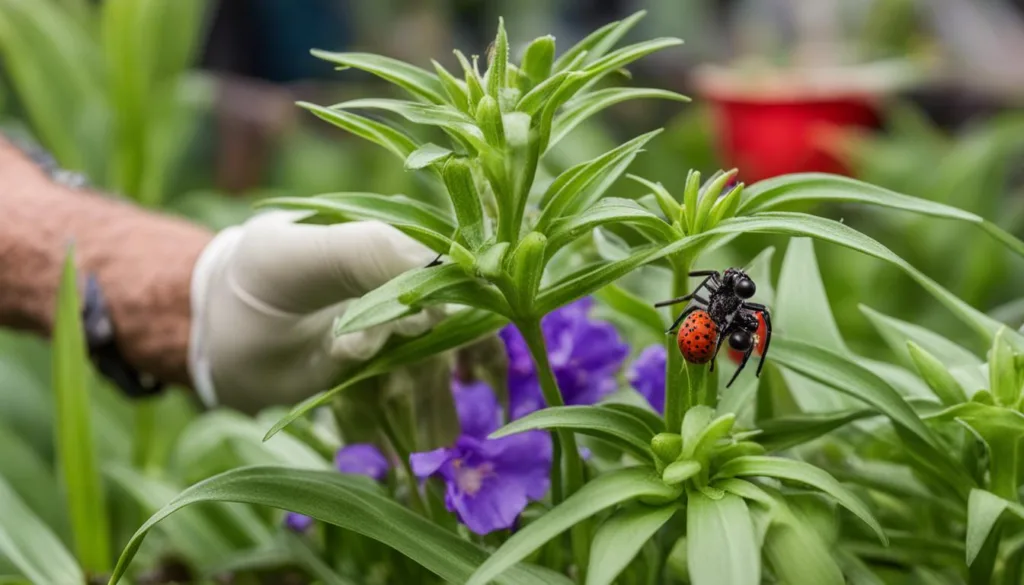
When it comes to spiderwort plants, pest and disease issues are generally minimal. However, there are a few common problems that can occur. By following proper management techniques, you can keep your spiderwort plants healthy and thriving.
Pest Management
Two common pests that can affect spiderwort plants are aphids and spider mites. Aphids are small, sap-sucking insects that can cause stunted growth, distorted leaves, and the presence of sticky honeydew. Spider mites, on the other hand, are tiny arachnids that feed on plant sap and can cause yellowing, stippling, and webbing on the leaves.
To manage aphids and spider mites, regular monitoring is essential. If you spot an infestation, you can try spraying your plants with a strong stream of water to dislodge the pests.
In severe cases, mild insecticides or horticultural oils can be used to control the population. It’s important to read and follow the instructions on the product label for safe and effective use.
Disease Management
Spiderwort plants are generally resistant to diseases. However, overwatering or poor drainage can lead to root rot or fungal diseases, such as powdery mildew. To prevent these issues, it’s important to provide proper watering and ensure the soil is well-drained. Avoid overwatering and allow the soil to dry slightly between waterings.
In addition, maintaining good air circulation around the plants can help prevent fungal diseases. Avoid overcrowding and remove any dead or decaying plant material from the area.
If you notice signs of disease, such as discolored or wilting foliage, it’s important to take action promptly. Pruning affected areas and applying appropriate fungicides can help manage the problem.
| Pest/Disease | Symptoms | Management |
|---|---|---|
| Aphids | Stunted growth, distorted leaves, presence of sticky honeydew | – Spray plants with water to dislodge pests – Use mild insecticides if needed |
| Spider Mites | Yellowing, stippling, webbing on leaves | – Spray plants with water to dislodge pests – Use mild insecticides if needed |
| Root Rot/Fungal Diseases | Wilting, discolored foliage | – Provide well-drained soil and avoid overwatering – Prune affected areas – Apply appropriate fungicides |
By implementing these pest and disease management techniques, you can ensure that your spiderwort plants remain healthy and vibrant. Regular monitoring, proper watering, and timely action are key to maintaining the beauty and longevity of these lovely plants.
Spiderwort Winter Care
As winter approaches, it is important to prepare your spiderwort plants for the cold months ahead. While spiderwort plants are hardy to USDA zone 4b and can withstand winter conditions, there are a few steps you can take to ensure their survival and promote healthy growth in the following years.
Firstly, after the flowering season is over, it is recommended to cut back the stems of your spiderwort plants. This helps prevent overgrowth and allows the plants to conserve energy during the dormant period. Simply trim the stems close to the ground, removing any dead or damaged parts.
In addition to cutting back the stems, it is also a good idea to divide your spiderwort plants every three years. This not only helps control their size but also promotes new growth and prevents overcrowding.
Carefully dig up the plants and separate them into smaller clumps, ensuring each division has a healthy root system. Replant the divisions at the same depth as before and water thoroughly.
In colder climates where spiderwort plants are not hardy, they can be grown as annuals or brought indoors for the winter. If you choose to bring them indoors, place the plants in a bright location away from drafts.
Water sparingly, as the plants will require less moisture during the dormant period. Resume regular watering and fertilizing in the spring when new growth appears.
FAQ
How do I care for spiderwort plants?
Spiderwort plants are easy to care for. Plant them in moist, well-drained soil in the spring and water every few days, especially during hot summer months. They prefer partial shade but can tolerate full sun. Regular pruning and shearing after flowering will help maintain a neat appearance and prevent self-sowing.
Are spiderwort plants toxic to humans and pets?
Yes, spiderwort plants are toxic if ingested by humans and pets. Keep them out of reach of children and animals to avoid any potential health issues.
Can spiderwort plants be grown indoors as houseplants?
While some spiderwort species can be grown as houseplants, T. ohiensis, T. virginiana, and T. subaspera are best suited for outdoor gardens due to their fast-growing and sprawling nature. Indoor spiderwort plants should be placed in bright filtered light and kept in soilless or loam-based potting compost. Regular pinching out of growing tips will encourage bushier growth. Adequate humidity levels and moderate watering are important for indoor spiderwort care.
How tall do spiderwort plants grow?
Spiderwort plants have grass-like leaves that arch and can grow between 1 to 3 feet in height.
How often should I water spiderwort plants?
Spiderwort plants prefer consistently moist soil. Water them regularly, particularly in summer, to keep the soil moist but not waterlogged.
Do spiderwort plants attract pollinators?
Yes, spiderwort plants are known to attract pollinators such as bees and butterflies with their nectar-rich flowers.
What are the different varieties of spiderwort available?
There are many different varieties of spiderwort available, including Tradescantia ‘Amethyst Kiss’, Tradescantia ‘Concord Grape’, Tradescantia ‘Red Grape’, Tradescantia ‘Sweet Kate’, and Tradescantia ‘Purple Profusion’. These varieties have different leaf and flower colors and can be grown in various sunlight conditions.
How do I propagate spiderwort plants?
Spiderwort plants can be propagated through division or stem cuttings. Divide the plants every three years to prevent overgrowth and maintain plant health.
What are the growing conditions for spiderwort plants?
Spiderwort plants are resilient and can tolerate a variety of soil conditions and pH levels. They prefer partial shade but can also thrive in sunny areas. They are hardy in USDA zones 4b to 12a and should be planted in the spring with adequate spacing between plants.
What are some common pests and diseases that affect spiderwort plants?
Spiderwort plants do not have any serious pest or disease problems. However, they can be susceptible to aphids and spider mites. Regular monitoring and treatment with mild insecticides or horticultural oils can help manage these infestations.
How do I care for spiderwort plants during winter?
Spiderwort plants are hardy to USDA zone 4b and do not require winter protection. However, it is important to cut back the stems after flowering and divide the plants every three years to prevent overgrowth. Adequate care and maintenance throughout the growing season will promote healthy winter dormancy and ensure successful growth in the following years.

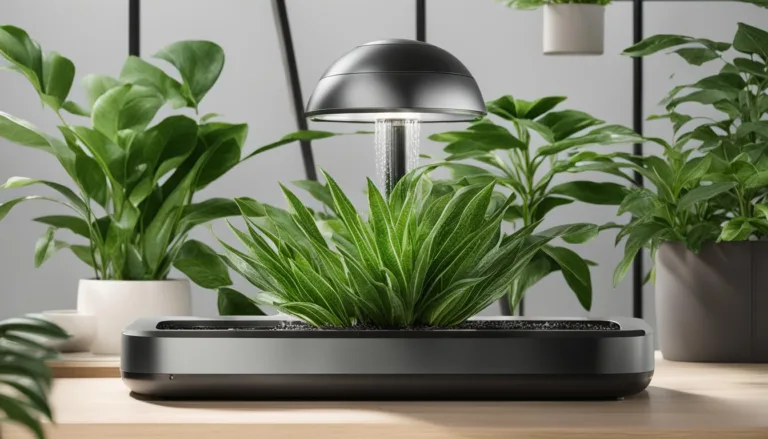
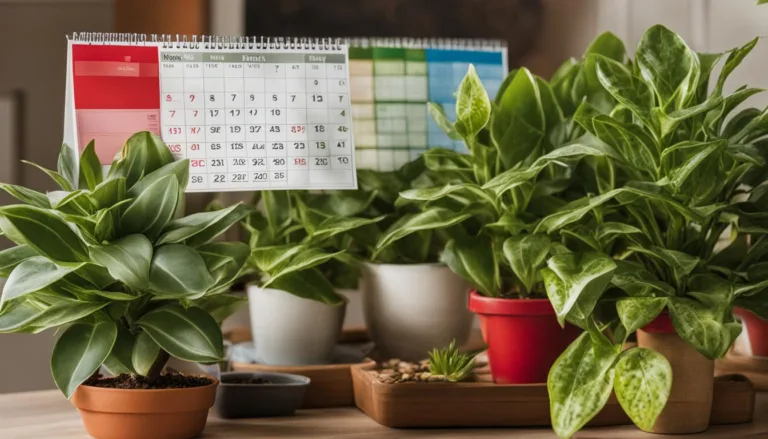
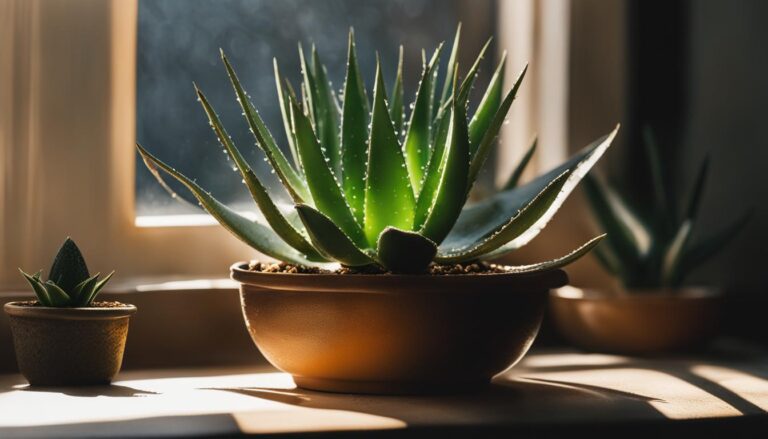


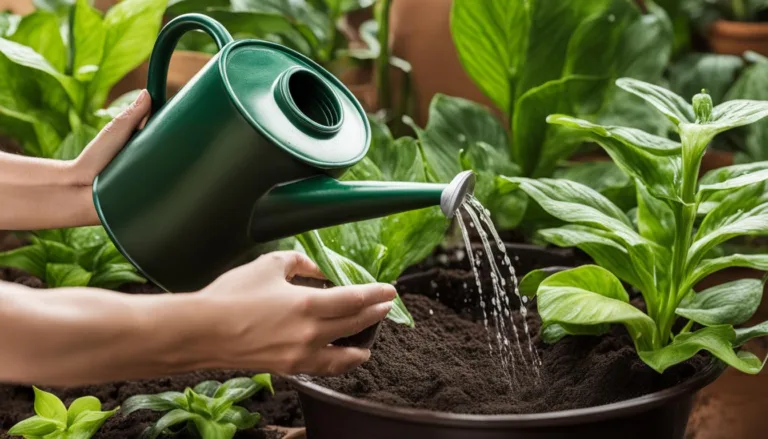
Aw, this was an incredibly nice post. Taking the time and actual effort to produce a very good article… but what can I say… I procrastinate a whole lot and never seem to get anything done.
Cultivate mindfulness